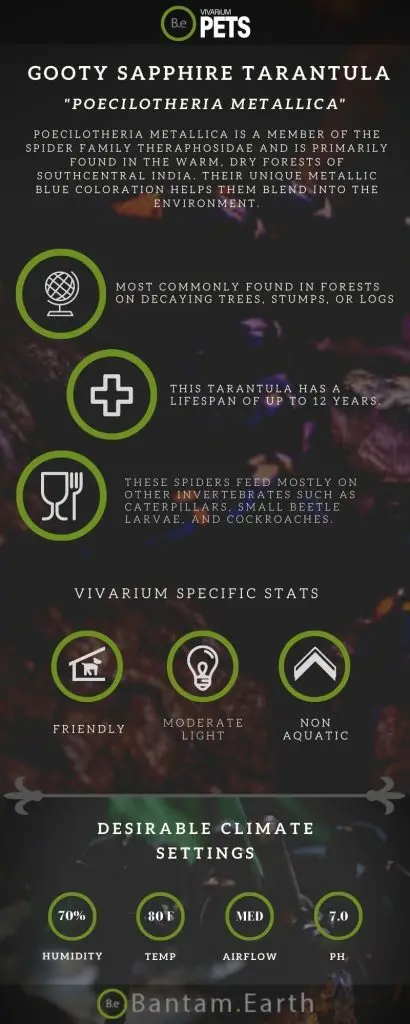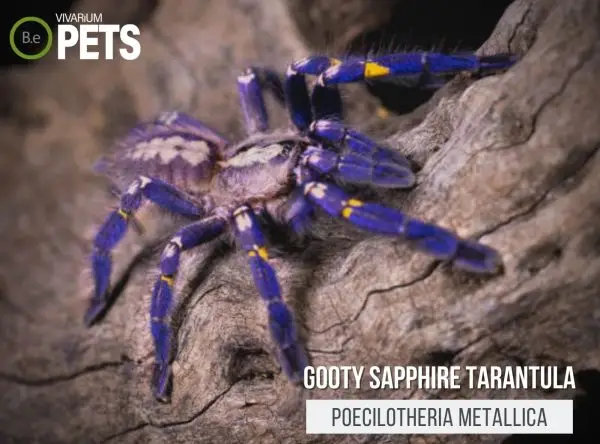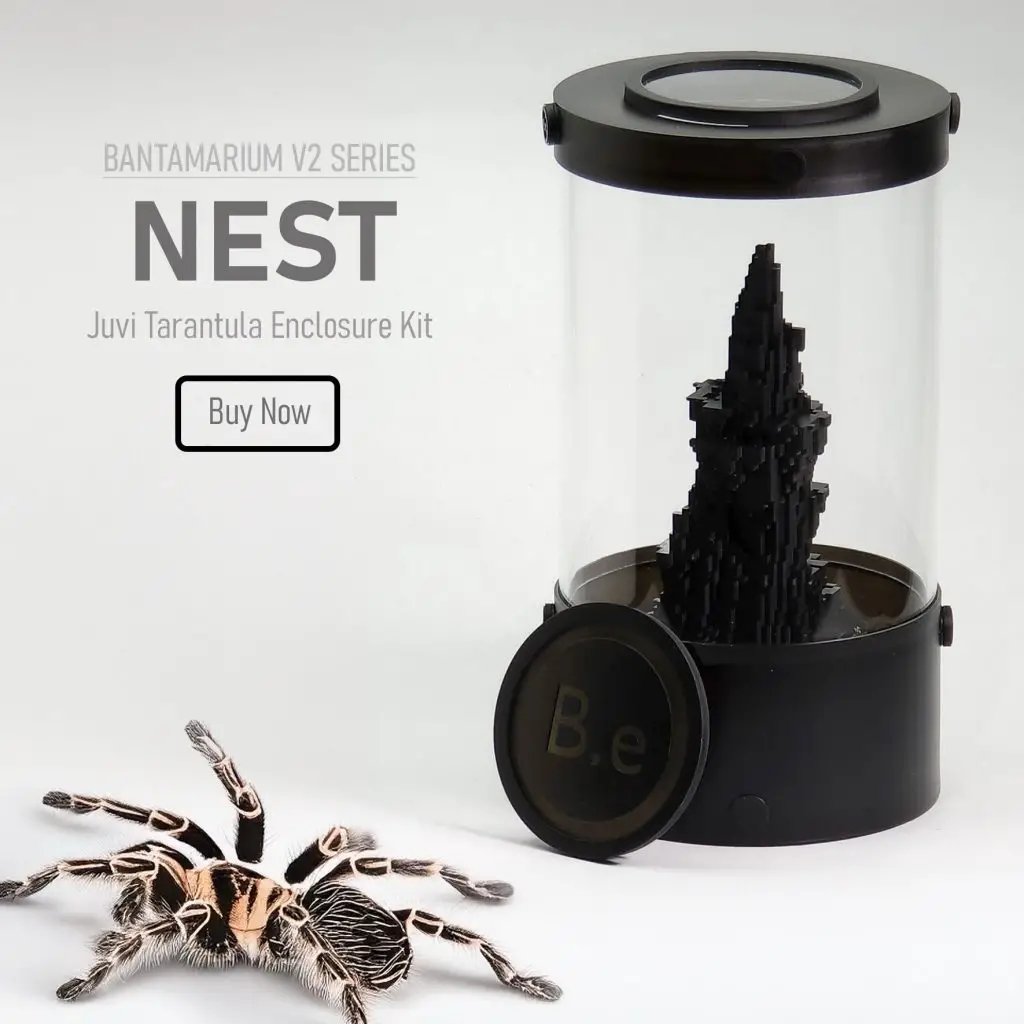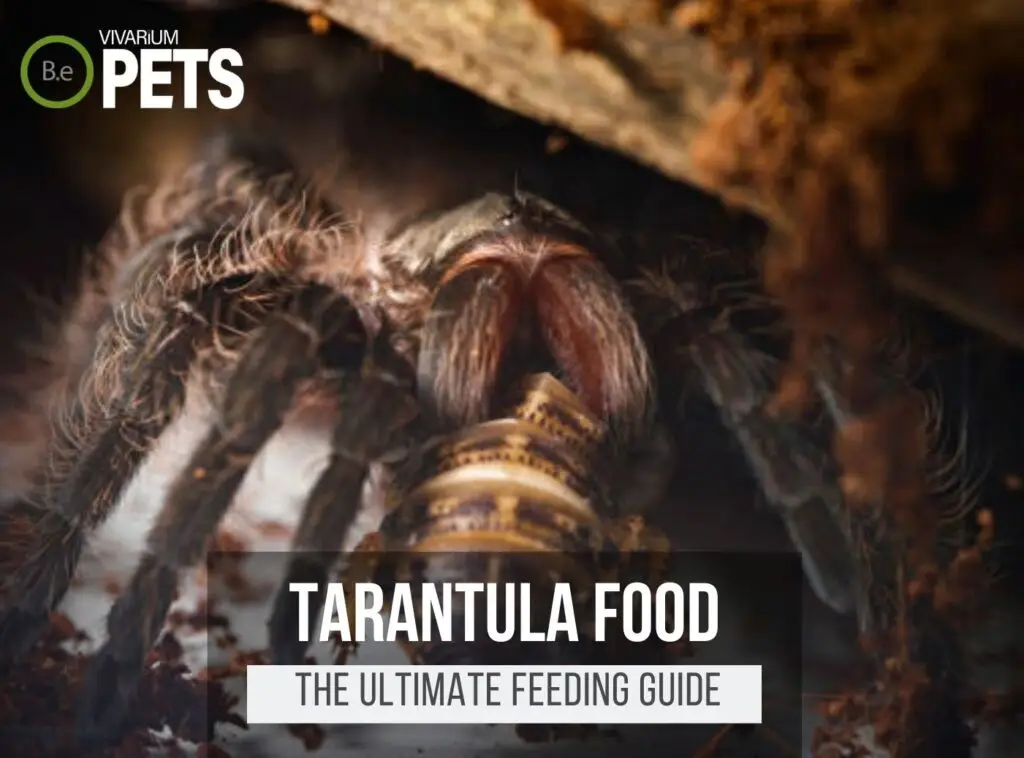The Gooty Sapphire Tarantula a.k.a the Peacock Tarantula is a vibe and one of the rarer types of tarantulas to have as a pet.
Not only are they fascinating to look at, but they are also relatively easy to care for.
In this guide, we will take a look at everything you need to know about owning and caring for Poecilotheria metallica.
We will explore topics such as proper humidity levels, enclosure type, diet requirements, and handling techniques.
Read on to learn more about the blue tarantula and how to provide it with the best care and attention it needs!
Table Of Contents:
ToggleWhat Are Gooty Sapphire Tarantulas?
Poecilotheria metallica is a member of the spider family Theraphosidae and is primarily found in the warm, dry forests of south-central India.
Their unique metallic blue coloration helps them blend into the environment.
These spiders are considered beautiful and interesting, and their popularity as pets has grown over the last decade.
They are a medium-sized species of tarantula and are unique in that they build web retreats in trees rather than burrows like many other tarantulas.
The name Gooty Sapphire comes from the town of Gooty in south-central India where these spiders were first found.
Create the perfect home for your arachnid with our Customizable Spider Enclosure Kits, designed to meet all their habitat needs.
What Do Gooty Sapphire Tarantulas Look Like?
Gooty Sapphire Tarantulas are most recognized by their blue-colored bodies and bright yellow spots which cover their midsection.
Upon close inspection, you may also notice their unique metallic-looking hairs.
Generally, Poecilotheria metallica grows to medium size, measuring between 4.7-6 inches for males and 5.5-8 inches for females.
Their stout legs and powerful body allow them to traverse across sand, rocks, and soil.
On the underside of their abdomens, they have two long, curved fangs.
Although these can weather small prey, it is generally used for defensive purposes.
The Peacock Tarantula can also have an intimidating presence when threatened, flicking their short claws and urticating hairs out at attackers.
Benefits Of Using Gooty Sapphire Tarantulas
The Gooty Sapphire Tarantula can be a great addition to any vivarium.
Not only can they live happily alongside other inhabitants, but their colorful bodies and impressive web-building techniques can add a beautiful and fascinating element to a habitat.
Their attractive colorations can be somewhat intimidating to potential predators, while their climbing and jumping abilities can provide a unique and interesting look.
With proper care and setting, Poecilotheria metallica can be a happily thriving, and enjoyable addition to your enclosure.
Additionally, as they require much less space than other inhabitants, they can be a wonderful addition to a smaller setup.

Gooty Sapphire Tarantula Facts
Gooty Sapphire Tarantulas are a vibrant and active species of spider found in India.
Poecilotheria metallica is considered to be a calm species, however, they can be skittish when handled.
Breeding is possible when the female reaches maturity and usually lays a few egg sacs.
Habitat
Poecilotheria metallica is native to the Indian states of Andhra Pradesh and Tamil Nadu.
They are most commonly found in forests on decaying trees, stumps, or logs.
It has also been spotted in homes, gardens, and other human-made structures in and around human settlements.
Replicate their natural habitat perfectly with our bioactive species-specific soil mixes, designed to provide the ideal moisture and organic content for your spiders.
Diet
In their natural habitat, these spiders feed mostly on other invertebrates such as caterpillars, small beetle larvae, and cockroaches.
They are also known to scavenge for dead insects or small mammals.
To obtain the nutrition they need, Gooty Sapphire Tarantulas hunt at night and rely on their excellent eyesight and ability to detect vibrations on the ground.
Temperament
When first encountering Poecilotheria metallica, it is wise to remember that they are wild animals and can be unpredictable.
However, with regular handling and adequate care, they can become accustomed to humans and even become quite docile.
Generally, Gooty Sapphire Tarantulas will only bite when they feel threatened or are mishandled.
They are solitary creatures, so they should never be housed with other tarantulas or equally valued animals.
Lifespan
The lifespan of Gooty Sapphire Tarantulas varies depending on sex.
The female of the species lives up to 11-12 years while the males typically live up to 3-4 years.
This species of tarantula goes through multiple stages of growth – egg, spiderling, sub-adult, and adult – before reaching maturity.
The egg stage can last a few weeks until the spiderling emerges. Spiderlings usually take a few months to reach the sub-adult stage.
Sub-adults take 6-10 months to reach sexual maturity and become viable for reproduction.
Breeding
Poecilotheria metallica typically mate during the spring, although they can also mate in the winter under the right conditions.
It is good to remember that they come from tropical habitats and require high temperatures.
When they are ready to mate, the female will wait for a male to appear.
The male will approach the female to begin courtship rituals, such as vibrating and drumming the ground near the female.
After a successful courtship, the male will insert his pedipalps into the female’s reproductive orifice.
The male Peacock Tarantula then releases a sperm packet which is received by the female.
Once the mating process is complete, the female will lay her eggs – usually about 100 of them.
She will carefully protect the eggs and tend to them until they hatch.
The eggs will hatch anywhere from six to twelve weeks after mating, depending on the environment.
Upon hatching, the baby spiders will stay with the mother for several days or weeks while they molt, until they are large enough to venture out on their own.
Where To Find Gooty Sapphire Tarantulas
When searching for a Gooty Sapphire Tarantula in the wild, it’s best to look in areas of dense foliage that have good moisture levels.
Finding them for sale is quite easy. There are numerous online stores and pet shops that offer them.
They are generally more expensive than other species of tarantulas due to their rarity and the difficulty of shipping them, but prices may vary depending on where you buy them.
It’s also good practice to buy from reputable sources and to confirm that the P. metallica you purchase is healthy.
Many online sellers provide detailed photos and health histories of their specimens.
Gooty Sapphire Tarantula Care
To care for Poecilotheria metallica, provide proper humidity, terrarium substrate, temperature, enclosure, and diet, and handle with care.
Make sure to provide moisture by misting the enclosure regularly and feeding the tarantula the right food depending on the species’ size.
Troubleshooting problems such as health issues or environmental stressors is important as well.
Tank Requirements
The Gooty Sapphire Tarantula needs a 10-20 gallon terrarium with a secure, tight-fitting lid.
The ideal type of vivarium should be made of glass or plastic to withstand their burrowing habits.
The preferable substrate should be coconut fiber, sphagnum moss, or soil with hardwood chunks.
The water’s pH should be between 6.5-7.5, and the hardness should be at a minimum of 3 dH.
The temperature should remain consistent (77-86 degrees Fahrenheit) and the where humidity levels should range between 60-80%.
As for terrarium lighting, UVA and UVB lights are unnecessary, but it is recommended to provide a natural day-night cycle with low-light baskets.
What Do Gooty Sapphire Tarantulas Eat?
Feeding Poecilotheria metallica should be done once a week, providing them with enough food for one week.
Here are some items you can feed your Gooty Sapphire Tarantula:
• Crickets
• Mealworms
• Superworms
• Waxworms
• Silkworms
• Earthworms
• Cockroaches
When feeding your tarantula be sure to place the insect or other food item in the enclosure.
Do not try to hand-feed your spider.
Additionally, remove any uneaten food after 48 hours, as it may rot and fungus could begin to grow.
Lastly, make sure to provide your arachnid with fresh water.
If you’re looking for a more detailed approach to feeding these arachnids, be sure to check out my ultimate DIY tarantula food guide. I give a more in-depth explanation of the best foods and my favorite recipe.
Best Tankmates For Gooty Sapphire Tarantulas
The Gooty Sapphire Tarantula is a solitary creature and is best kept alone.
While they may not interact with their cage mates, some people prefer to keep other species of small animals in the same enclosure to keep them company.
Of these species, there are a few that make good tank mates for the tarantula.
Some beneficial species include isopods, springtails, snails, and small millipedes.
These species share some of the same needs such as humidity and temperature as the Poecilotheria metallica and do not pose a threat to it as they tend to keep to themselves.
They are also great at keeping the vivarium clean as they munch on uneaten food, mold, fungi, and other unwanted debris left around the tank.
Conclusion
Owning a Gooty Sapphire Tarantula can be an incredibly rewarding experience.
With the right knowledge and guidance, you can create an environment where your companion will thrive.
Make sure to follow these guidelines to ensure Poecilotheria metallica is comfortable and healthy.
With a bit of research and dedication, you are certain to have a new fascinating pet that you can take pride in owning and caring for.
Create the ideal habitat for your arachnids with our species-specific soil mixes and Spider Enclosure Kits. These products provide everything you need for a thriving spider habitat.
Frequently Asked Questions
The Gooty sapphire tarantula is highly venomous and has a painful bite, though it is not considered deadly to humans.
Gooty sapphire tarantulas are not recommended for beginners due to their fast and defensive nature.
Gooty sapphire tarantulas are native to the deciduous forests of the Gooty region in the Indian state of Andhra Pradesh.
Gooty sapphire tarantulas primarily feed on insects, such as crickets and roaches.
No, Poecilotheria metallica is not typically very docile. They are known for their defensive behavior and can be skittish and semi aggressive when provoked.







